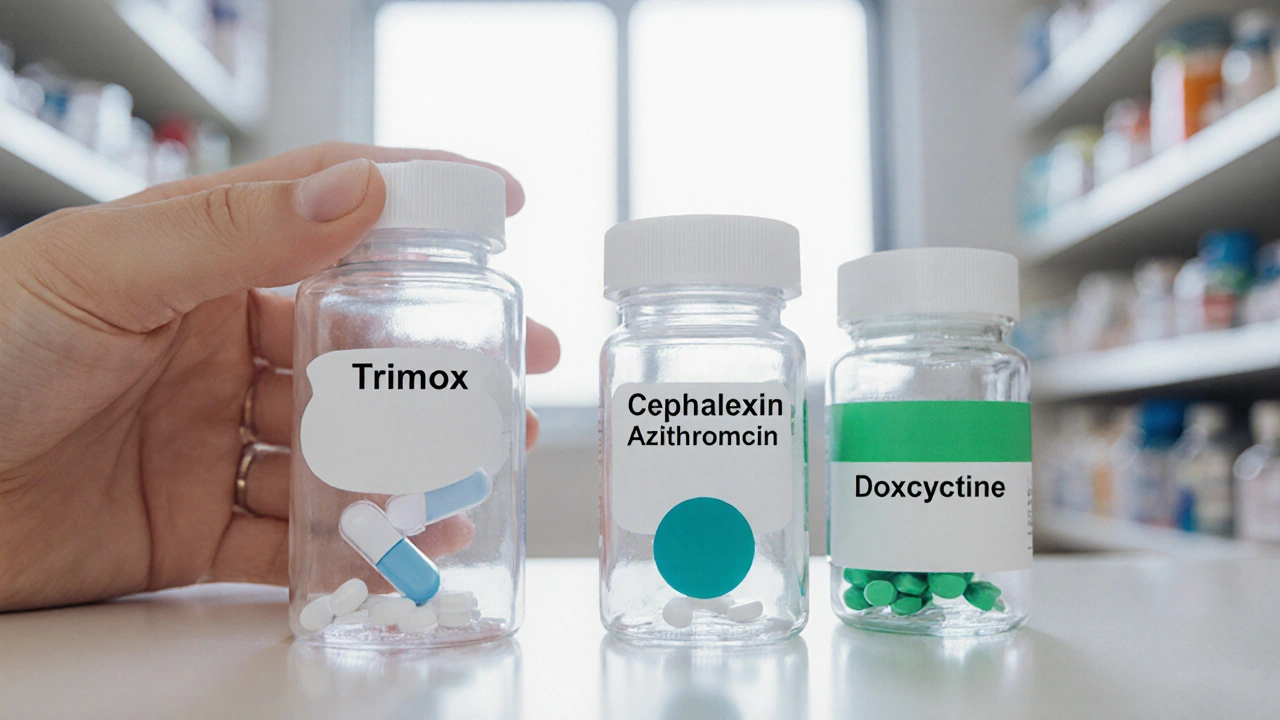Antibiotic Selection Tool
Find Your Best Antibiotic Option
This tool helps you determine the most appropriate antibiotic based on your specific infection, allergies, and other factors. Results are based on clinical guidelines and resistance patterns.
If you’ve ever wondered whether Trimox is the right antibiotic for you, you’re not alone. Choosing the right drug can feel like navigating a maze of brand names, dosages, and side‑effect profiles. This guide breaks down Trimox, shows how it stacks up against common alternatives, and gives you practical tips for making an informed decision.
Key Takeaways
- Trimox is a branded form of amoxicillin, a penicillin‑type antibiotic.
- It works best for mild‑to‑moderate infections caused by susceptible bacteria.
- Common alternatives include cephalexin, azithromycin, doxycycline, and amoxicillin‑clavulanate (Augmentin).
- Consider spectrum, dosing frequency, side‑effect risk, and cost when picking an option.
- Always check for drug interactions and local antibiotic‑resistance patterns.
What is Trimox?
Trimox is a branded formulation of amoxicillin, a broad‑spectrum penicillin antibiotic that inhibits bacterial cell‑wall synthesis. It was introduced in the early 1990s and quickly became a go‑to for ear, sinus, throat, and urinary‑tract infections. The drug is marketed in 250mg and 500mg tablets, as well as a pediatric suspension.
How Trimox Works
Amoxicillin (the active ingredient in Trimox) binds to penicillin‑binding proteins, preventing the cross‑linking of peptidoglycan layers in bacterial cell walls. Without a sturdy wall, bacteria burst under osmotic pressure. This mechanism is effective primarily against gram‑positive organisms like Streptococcus pneumoniae and some gram‑negative species such as Haemophilus influenzae.
Because it targets a fundamental bacterial process, resistance can develop when bacteria produce β‑lactamases that degrade the drug. In many regions, rising resistance has prompted clinicians to reserve amoxicillin for infections where susceptibility is confirmed.

Typical Uses and Dosage
Common indications for Trimox include:
- Acute otitis media
- Sinusitis
- Pharyngitis (strep throat)
- Uncomplicated urinary‑tract infection
- Dental abscesses
Standard adult dosing is 500mg every 8hours or 875mg twice daily, depending on infection severity. For children, the pediatric suspension is typically dosed at 25-45mg/kg per day divided into two or three doses. Amoxicillin dosage must be adjusted for renal impairment.
Common Alternatives
When Trimox isn’t suitable-because of allergy, resistance, or dosing convenience-clinicians often turn to other agents. Below are the most frequently prescribed alternatives, each introduced with a brief definition.
Cephalexin is a first‑generation cephalosporin that offers a similar spectrum but is more resistant to β‑lactamase degradation.
Azithromycin belongs to the macrolide class; it concentrates in tissues and is taken once daily for 3-5days.
Doxycycline is a tetracycline derivative effective against atypical organisms and Lyme disease.
Amoxicillin‑clavulanate, sold as Augmentin, pairs amoxicillin with a β‑lactamase inhibitor to broaden coverage.
Clarithromycin is another macrolide, often used when azithromycin isn’t available.
Side‑Effect Profile Comparison
| Antibiotic | Spectrum | Typical Adult Dose | Common Side Effects | Cost (AU$ per course) |
|---|---|---|---|---|
| Trimox (amoxicillin) | Gram‑positive + limited gram‑negative | 500mg q8h or 875mg bid | GI upset, rash, rare liver enzyme rise | ~$12-$15 |
| Cephalexin | Similar to amoxicillin, better β‑lactamase stability | 500mg q6h | Diarrhea, mild allergic reactions | ~$10-$13 |
| Azithromycin | Broad, especially atypicals | 500mg day1 then 250mg days2‑5 | GI upset, QT prolongation (rare) | ~$18-$22 |
| Doxycycline | Broad, good for intracellular bugs | 100mg bid | Photosensitivity, esophagitis | ~$15-$20 |
| Amoxicillin‑clavulanate | Expanded gram‑negative + β‑lactamase‑producing strains | 875mg/125mg q8h | Diarrhea (often severe), liver enzyme rise | ~$20-$25 |
| Clarithromycin | Similar to azithromycin, better for H. pylori | 500mg bid | Metallic taste, GI upset, drug interactions | ~$22-$27 |

When to Choose Trimox Over Alternatives
Trimox shines in situations where the infecting organism is known to be susceptible to amoxicillin and a short, twice‑daily regimen is desirable. Example scenarios:
- Confirmed streptococcal pharyngitis-single‑dose efficacy and low cost.
- Children with mild otitis media-palatable suspension and well‑established safety.
- Patients without a penicillin allergy and with normal renal function.
If local antibiograms show high rates of β‑lactamase‑producing H. influenzae, an amoxicillin‑clavulanate or a cephalosporin may be wiser. For atypical pathogens like Mycoplasma pneumoniae, macrolides (azithromycin, clarithromycin) are preferred because amoxicillin has no activity.
Safety, Interactions, and Resistance Concerns
All antibiotics carry a risk of disrupting gut flora, potentially leading to Clostridioides difficile infection. Trimox’s relatively narrow spectrum makes this risk slightly lower than broad‑spectrum agents like azithromycin.
Key drug interactions:
- Concurrent use of oral anticoagulants (warfarin) may boost INR-monitor closely.
- Probenecid can raise amoxicillin plasma levels; adjust dose if used.
- Live vaccines (e.g., MMR) should be spaced at least two weeks after a full antibiotic course.
For patients with a documented penicillin allergy, avoid Trimox and opt for a macrolide or doxycycline, unless desensitization is performed.
Practical Tips for Patients
- Finish the entire prescribed course-even if symptoms improve.
- Take the tablet with food or a full glass of water to lessen stomach upset.
- Store suspension in the refrigerator; shake well before each dose.
- Report any severe rash, difficulty breathing, or persistent diarrhea to a healthcare professional immediately.
Frequently Asked Questions
Is Trimox the same as generic amoxicillin?
Trimox contains the same active ingredient-amoxicillin-as generic versions, but it is marketed under a brand name and may have different inactive fillers.
Can I take Trimox if I’m allergic to penicillin?
No. Trimox is a penicillin derivative, so a true penicillin allergy means you should avoid it and discuss alternatives with your doctor.
How does the cost of Trimox compare to Augmentin?
In Australia, a standard 7‑day course of Trimox costs roughly AU$12-$15, while Augmentin (amoxicillin‑clavulanate) typically runs AU$20-$25, reflecting the added β‑lactamase inhibitor.
When is a macrolide a better choice than Trimox?
Macrolides like azithromycin are preferred for atypical pneumonia, certain sexually transmitted infections, or when the patient has a confirmed penicillin allergy.
What should I do if I miss a dose of Trimox?
Take the missed dose as soon as you remember, unless it’s almost time for the next dose. In that case, skip the missed one-don’t double up.







Matt Cress
October 14, 2025 AT 17:58So you’ve finally decided to compare Trimox with every other antibiotic ever invented, huh? Let me tell you why that’s a brilliant use of your precious internet time. First off, amoxicillin isn’t some magical unicorn that solves every infection without side effects. It’s a penicillin, which means it fights gram‑positive bugs nicely but gets tripped up by β‑lactamases faster than you can say “resistance.” If you live in a place where Haemophilus influenzae churns out beta‑lactamases, you’ll be reaching for Augmentin before you even finish the first dose of Trimox. Second, the cost comparison in the table is basically a joke because you’re ignoring pharmacy mark‑ups and insurance copays. A $12 course in Australia translates to maybe $30‑$40 here, depending on your plan. And don’t even get me started on the “palatable suspension” for kids; it tastes like sweet‑lime medicine that makes toddlers retreat in terror. But hey, if you love giving your child a syrup that looks like a smoothie and smells like a chemicals lab, go for it. Third, the side‑effect profile isn’t just “GI upset and rash.” You can get Clostridioides difficile colitis even from a narrow‑spectrum drug if your gut flora is already compromised. That’s why you should always pair antibiotics with probiotics, a fact the guide conveniently skips over. Fourth, the table’s “β‑lactamase stability” line for cephalexin ignores the fact that cephalosporins can cross‑react in up to 10% of penicillin‑allergic patients. So swapping to cephalexin because you hate “amoxicillin‑clavulanate” might land you back in the allergy clinic. Finally, remember that guidelines are not law; they’re a suggestion based on population‑level data, not your single case of sore throat. If your doctor says Trimox is fine, trust them over a generic internet chart, because they actually see you.
Maggie Hewitt
October 19, 2025 AT 19:58Wow, the sarcasm meter is totally broken here.
Mike Brindisi
October 24, 2025 AT 21:58Look the thing about Trimox is it covers a lot of typical respiratory bugs but if you have a beta lactamase producing strain you are basically throwing money away and you need something like augmentin or a cephalosporin the guidelines actually say that you should consider local resistance patterns before just picking amoxicillin because otherwise you get treatment failure and that's a waste of resources.
Steven Waller
October 29, 2025 AT 23:58When weighing Trimox against alternatives, it's worth reflecting on the broader principle of antibiotic stewardship. Choosing the narrowest effective agent protects our collective microbiome and preserves the utility of broader drugs for when they're truly needed. This mindset aligns with both patient safety and public health goals.
Puspendra Dubey
November 4, 2025 AT 01:58i cant help but feel that this whole comparison is like a drama epics of health, where trimox is the hero with a shiny cape but the villains – resistance and allergies – are lurking in the shadows waiting to betray the unsuspecting.
Shaquel Jackson
November 9, 2025 AT 03:58i guess the guide does a decent job but it kinda feels like a lazy summary 😒.
Tom Bon
November 14, 2025 AT 05:58In regard to the presented data, I would like to note that the cost analysis does not account for regional pharmacy pricing variations, which may influence the decision‑making process for both clinicians and patients.
Clara Walker
November 19, 2025 AT 07:58One must consider that pharmaceutical companies often fund such comparative tools, subtly guiding prescribers toward higher‑margin products under the guise of neutrality.
Jana Winter
November 24, 2025 AT 09:58The article contains several grammatical oversights; for instance, the phrase "β‑lactamase‑producing strains" should be hyphenated consistently, and the term "Clostridioides difficile" is capitalized incorrectly in some instances.
Linda Lavender
November 29, 2025 AT 11:58In the grand theatre of antimicrobial selection, Trimox takes centre stage with the flourish of a seasoned actor, delivering line after line of efficacy against streptococcal villains. Yet, behind the curtain, the supporting cast-cephalexin, azithromycin, and doxycycline-each possess their own nuanced performances, singing solos of beta‑lactamase resistance, tissue penetration, and patient compliance. The audience, that is the prescriber, must weigh the applause of cost against the hush of side‑effects, and the final bow is often dictated not by the script but by the ever‑changing epidemiology of microbial antagonists.